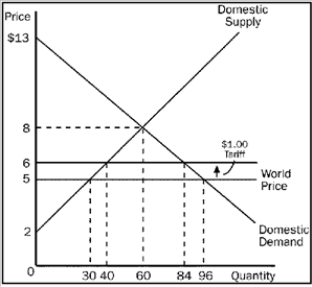Using the graph, assume that the government imposes a $1 tariff on hammers. Answer the following questions given this information. 
a. What is the domestic price and quantity demanded of hammers after the tariff is imposed?
b. What is the quantity of hammers imported before the tariff?
c. What is the quantity of hammers imported after the tariff?
d. What would be the amount of consumer surplus before the tariff?
e. What would be the amount of consumer surplus after the tariff?
f. What would be the amount of producer surplus before the tariff?
g. What would be the amount of producer surplus after the tariff?
h. What would be the amount of government revenue because of the tariff?
i. What would be the total amount of deadweight loss due to the tariff?
Definitions:
Central Conflict
The primary disagreement or challenge that drives the narrative or situation.
Controlled Money
Money whose supply and value are regulated by a central authority, such as a government or central bank, to maintain economic stability.
Internationalization
The process of increasing involvement of enterprises in international markets, often through exporting, importing, foreign direct investment, or entering into international partnerships.
Labor Solidarity
The unity and mutual support within the labor movement, where workers across different sectors support each other's struggles and goals.
Q53: Refer to Figure 9-7. Which of the
Q58: Refer to Figure 10-1. This graph represents
Q61: Refer to Figure 9-1. With trade, Guatemala
Q158: Refer to Figure 10-10. The socially optimal
Q166: The imposition of a tariff on imported
Q218: Refer to Figure 10-9, Panel c). The
Q392: Since air pollution creates a negative externality,<br>A)
Q424: Refer to Figure 9-23. With free trade,
Q442: Which of the following is not an
Q493: Refer to Table 10-5. If the government